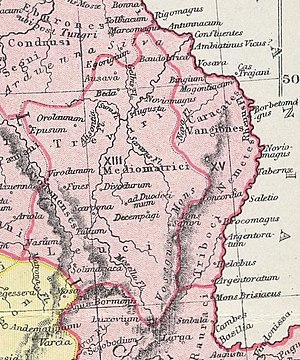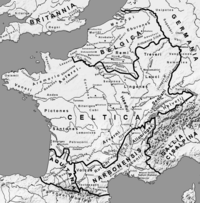Nemeter
The Nemeter (Latin: Nemetes or Nemeti ) were probably a Germanic tribe in the area of the Rhine between the Palatinate and Lake Constance .
First mention by Caesar
The Nemeters are first mentioned in De Bello Gallico by the Roman general and author Julius Caesar about the wars in Gaul . Accordingly, the Nemeters were around the year 70 BC. Chr. With other tribes under the leadership of the Germanic prince Ariovist invaded the area of the Gauls in search of new settlement area . According to Caesar, the Gauls, who were under the protectorate of the Roman Empire , asked Rome for help. Caesar then names the Nemeters among the seven tribes he found in a battle on the Rhine in 58 BC. Defeated BC. He mentions the name of the Nemeter again when he describes a forest area that, beginning in the Helvetier , Nemeter and Rauraker area, extends in a straight line towards the Danube to the Dacian and Anartian area .
Germans or Celts
Although Caesar refers to the seven tribes of the Battle of the Rhine as Germans (Latin Germani suas copias constituerunt ), the stand Nemeter by the common tribal goddess to Treviri close, a day known as Celtic tribe. Possibly the Nemeters were also Celts. About the ethnic affiliation of the tribes in the right bank of the Rhine fore of the Rhine is in the 1st century BC. Little known due to the so-called " Helvetier wasteland ". The settlement in the imperial territory probably did not take place until the reign of Augustus . Notes from Caesar himself belong to the “geographical excursions” that were probably added to the work in Augustan times at the earliest. In addition to an indirect mention of the geographer Strabo, Caesar's own statement that after the defeat of Ariovistus all the Suebi fled across the Rhine is more likely .
Report to Tacitus
In the 1st century AD, the Roman historian and senator Tacitus resorted to Caesar, whom he called a high authority , and in his historical report Germania names the Nemeters who, according to him, live directly on the left bank of the Rhine and are undoubtedly a Germanic people . However, he previously emphasized that there had been a back and forth between Gauls and Teutons on the banks of the Rhine and that some tribes were probably of Germanic origin only according to their own statements and their self-image. In another of his historical accounts, the Annals , Tacitus then counts the Nemeters as one of the Roman auxiliary peoples . Tacitus reports that the Nemeters were used together with Vangiones as auxiliary troops against invaded predatory chats and that they were able to surprise and defeat these predators in their sleep during an action. In doing so, they freed Roman soldiers and veterans of the Varus Battle from their forty-year captivity.
Settlement area of the Nemeter near Speyer
The Nemeters are believed to have established themselves as a Germanic people as early as 70 BC under the leadership of Ariovistus . In the area of what is now the Palatinate city of Speyer on the Rhine, which is reflected in the Latin name of the city Noviomagus Nemetum . Noviomagus is a word of Celtic origin. The Roman historian Ammianus Marcellinus then mentioned the city as Nemetae around 300 AD.
The idea of a Germanic settlement of Speyer as early as the time of Ariovistus cannot be substantiated by the archaeological finds so far, according to which a Germanic settlement of the area around Speyer can only be proven for the 1st century AD.
Niemcy Német Neamț
In Slavic languages such as Polish , Germans are referred to as Niemcy . It has often been assumed that this term used by the Germans in Slavic languages comes from the Nemeter tribe, but it is controversial since an etymologically significant contact between the Nemeter and Slavic peoples is considered unlikely. In Hungarian and Romanian, the root word is borrowed from the Slavic languages.
literature
- Rainer Wiegels : Nemeter. In: Reallexikon der Germanischen Altertumskunde (RGA). 2nd Edition. Volume 21, Walter de Gruyter, Berlin / New York 2002, ISBN 3-11-017272-0 , pp. 66-69. ( online )
- Christoph Heinrich Friedrich Bialloblotzky: "German reading lessons. Selected from Wolfgang Menzel: History of the Germans , London 1838 (google books)
- Heinrich Kohlrausch: "History of Germany. From the Earliest Period to the Present Time". New York 1880. (google books)
Maps
- Samuel Butler: The Atlas of Ancient and Classical Geography. London 1907
Individual evidence
- ↑ Caesar, De bello Gallico , 1, 51-54.
- ^ Caesar, De bello Gallico , 6, 55.
- ^ Caesar: De bello Gallico 4, 10 and 6, 25.
- ^ Herbert Nesselhauf : The settlement of the Upper Rhine region in Roman times. In: Badische Fundberichte 19, 1951, pp. 71–85; Gertrud Lenz-Bernhard: Lopodunum III: The Neckarswebische settlement and Villa rustica in the "Ziegelscheuer" area: an investigation into the settlement history of the Upper Rhine Germans. Stuttgart 2003, p. 21 with further sources.
- ↑ Strabo 7, 1, 3.
- ^ Caesar: De bello Gallico 1, 53-54.
- ^ Tacitus, Germania 28.
- ^ Tacitus, Annalen, 12, 27.
- ↑ Ammianus Marcellinus: Res gestae, 15, 11, 8.
- ↑ cf. Academy of Sciences in Vienna: Memoranda, Volume 15. Austrian Academy of Sciences. Philosophical-Historical Class, Vienna 1867 [1] (out of date).


